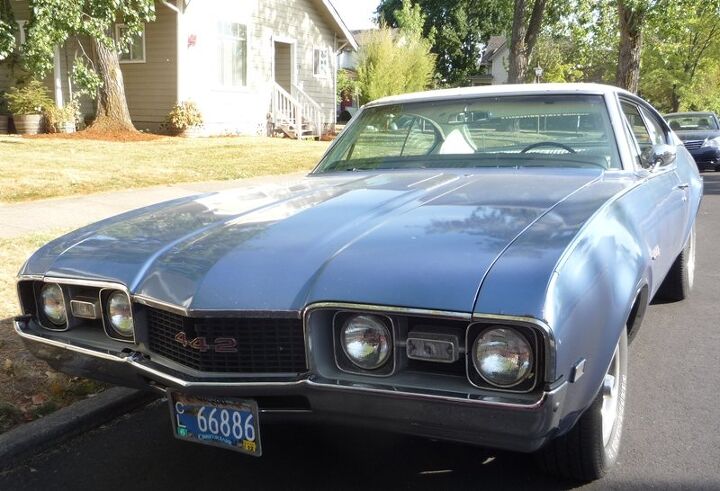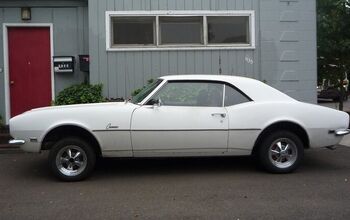Curbside Classic: 1968 Olsmobile 442

The Pontiac GTO generally gets bragging rights as the first of its kind: the classic intermediate-sized Detroit muscle car. It first appeared in 1964, and pretty much defined the category. But the Olds 442 also first saw the light of day in ’64, as a special performance package available on the F-85. The main differences between them: 59 cubic inches, 15 horsepower and healthy dollop of marketing savvy. The last one made all the difference: the Goat outsold the 442 by over ten to one in ’64. Chalk it up to John Z. DeLorean and the Mad Men.
Here’s the only 1964 442 ad I could come up with. Pretty odd too, showing a four door, in police trim. The 442 package was available on all ’64 F85s except wagons. But production figures show that a grand total of seven or eight of the four doors were ever built, out of a total of some 3k 442s that year. And its questionable if any of them were cop cars. Maybe they weren’t too hot on the four-speed stick. Oh well. But if you come across a four door ’64 442, don’t sell it cheap; who knows what that would be worth today.
That ad does make it clear what 442 stood for in 1964: 4-barrel carb; 4-on-the-floor; and dual exhausts.
Here’s a couple of ’64 GTO ads. Makes the 442 ad look like something from the forties. Never underestimate the power of (good) advertising. Pontiac sold over 32k GTOs in ’64 alone, and that was just the beginning.
Olds eventually changed agencies or demanded a new campaign, but it took a few years, and in the glory years of the 1970 W-30 455 CID 442, Olds’ 442 advertising featuring the diabolical Dr. Oldsmobile was pretty cutting edge, if not even ahead of its time ( here’s a story on Dr. O). But it was too late; the 442 never sold as well as the GTO or the Chevy SS396 Malibu, although the margin was narrowed considerably. In 1968, Pontiac moved 87k Goats, Chevy sold 67k SS396s, and Olds delivered a respectable 35k 442s. The corporate laggard was the Buick GS (20k), which was late to the performance party.
The 1968 GM intermediates were all-new, and the coupes rode on a shorter 112″ wheelbase. That gave them a distinctly more close-coupled look, and they were arguably the handsomest of the whole genre, perhaps ever. And the Olds version was the second best looking of the bunch, after the remarkably clean ’68 GTO with its pioneering body-colored nose. Unfortunately, the vinyl roof on this one rather mars the best feature of these cars: the C-pillar which creates a continuous plane and unbroken continuity of the lower and upper body halves. This was pioneered (in the US) by the ’66 Toronado, and the Cutlass/442 show it off very well indeed, when there’s no vinyl roof to interfere, that is.
Enough styling nitpicking. Performance was the 442’s calling card, and it delivered that, in varying degrees. The ’64 used a 310 hp high output 330 CID version of Olds’ new “small block” engine, which actually was just a short deck/short stroke version of the excellent big 425 CID engine. That’s because the corporate edict of no “big” motors in the intermediates. DeLorean managed to sneak the GTO by that surreptitiously. Once the GTO’s success was obvious, GM raised the limit to 400 CID.
The ’65 through ’67s 442s used a smaller bore version of the Olds 425, resulting in 400 CID. This engine had a forged crank, and was an ideal basis for further performance mods. But in 1968, Olds upped the big motor to 455 cubes, via an increase in stroke. For whatever reason, the 400 now shared the 455’s cast crank, but with a substantially reduced bore to keep it at 400 CID. The result is what has to be one of the the most undersquare modern American V8s: 3.87″ bore, 4.25″ stroke. Not ideal for maximum top-end performance, but undersquare engines tend to have a fabulously rich torque curve down low.
Since this is an automatic, it probably has the mild-cam 325 hp version anyway, anything but a wild and snorting performance motor. The manual transmission engine was rated at 350 hp, and 360 hp hi-po version was optional. The combination in this car is actually ideal for how this car is used: a daily driver by a young law student.
If that 400 engine looks small, it’s because it is, sort of. The big Olds was a remarkably compact engine, and not really a “big block”. Except for having a taller deck to make room for the longer stroke, it was otherwise essentially identical to the smaller 330/350 CID motors. Olds engines always enjoyed a good rep, especially for the quality of their blocks, which had a much higher nickel content than the Chevy engines. Well, at least through 1970; after that nickel for the castings became a victim of GM’s nickel and diming.
The 442 had its day in the sun in 1970, when the 455 finally found its way into the engine compartment, and Dr. Oldsmobile was pushing the W30 hi-po version, (under)rated at 370 hp to stay within GM’s 10 lbs. per hp edict. Additional performance packages were available above that even. By 1971, lowered compression for unleaded started the long decline. The 442 name was (ab)used by Olds for decades, even some four cylinder version of the Quad Four. Lets not even go there, at least not today.
It’s refreshing to run across cars like this being used as daily drivers. I’ve seen what seems to be an increase in vintage sixties performance iron around town near campus, in varying states of condition from decent to rough. Stay tuned.

More by Paul Niedermeyer
Latest Car Reviews
Read moreLatest Product Reviews
Read moreRecent Comments
- Lorenzo This car would have sold better if there was a kit to put fiberglass toast slices on the roof.
- Lorenzo The Malibu is close to what the 1955 Bel Air was, but 6 inches shorter in height, and 3 inches shorter in wheelbase, the former making it much more difficult to get into or out of. Grandma has to sit in front (groan) and she'll still have trouble getting in and out.The '55s had long options lists, but didn't include a 91 cubic inch four with a turbo, or a continuously variable transmission. Metal and decent fabric were replaced by cheap plastic too. The 1955 price was $1765 base, or $20,600 adjusted for inflation, but could be optioned up to $3,000 +/-, or $36,000, so in the same ballpark.The fuel economy, handling, and reliability are improved, but that's about it. Other than the fact that it means one fewer sedan available, there's no reason to be sorry it's being discontinued. Put the 1955 body on it and it'll sell like hotcakes, though.
- Calrson Fan We are already seeing multiple manufacturers steering away from EVs to Hybrids & PHEVs. Suspect the market will follow. Battery tech isn't anywhere close to where it needs to be for EV's to replace ICE's. Neither is the electrical grid or charging infrastructure. PHEV's still have the drawback that if you can't charge at home your not a potential customer. I've heard stories of people with Volts that never charge them but that's a unique kind of stupidity. If you can't or don't want to charge your PHEV then just get a hybrid.
- AZFelix The last time I missed the Malibu was when one swerved into my lane and I had to brake hard to avoid a collision. 1 out of 5⭐️. Do not recommend.
- 2ACL I won't miss it; it was decent at launch, but in addition to the bad packaging, GM did little to keep it relevant in the segment. I'd prefer that another domestic automaker doesn't just give up on the mainstream sedan, but unlike some of Ford's swan songs, the Malibu made an indifferent case for why they should live.











































Comments
Join the conversation
I had a 68 Cutlass 'S' convertible this same color in high school for a couple of years (1985-86). It was a column shift automatic, with a bench seat, power steering and non-assisted brakes. I paid $650 for it; the body was pretty much shot from rust, but the 350 4bbl ran well & it was a blast to put the top down and go. The exhaust was full of leaks from the manifold back, so I opted to have duals with "turbo flow" mufflers installed to take advantage of that great Olds V8 sound. My dad thought I was crazy to sink $125(!) worth of duals on such a beater, but he had to admit he loved the sound. Anyone know why Olds V8s had such a distinctive sound? Back then you could ID an Olds V8 coming down your block with your eyes closed...
I won't even bother regarding your post, but I can't help but reply on your comment about points. First of all, you did not need to use a feeler gauge and bump the engine over on gm products. They had a little window on the distributor cap that lined up with a hex screw that you turned to set the points with. all you had to do was preset the gap so it was close, then you could start the engine and adjust the points with it running using the dwell gauge. It took just a few seconds to do! No need to mess with the plate screws, as their only purpose on the gm's was to hold the points set in place, all of the adjustment took place from the separate hex screw that I mentioned earlier. The fords and chryslers had to be set the other way, but it sure didn't take an hour, maybe a few minutes of you were slow. And you did not have to rotate the engine by hand, you could either have someone bump the ignition key or you bumped the engine over from under the hood with your remote starter, which cost about 10 bucks for a good one back then. Points ignition systems are irrelevant since practically no one uses them anymore, so why even bring them up? I'm not even wasting my time on your posts anymore.